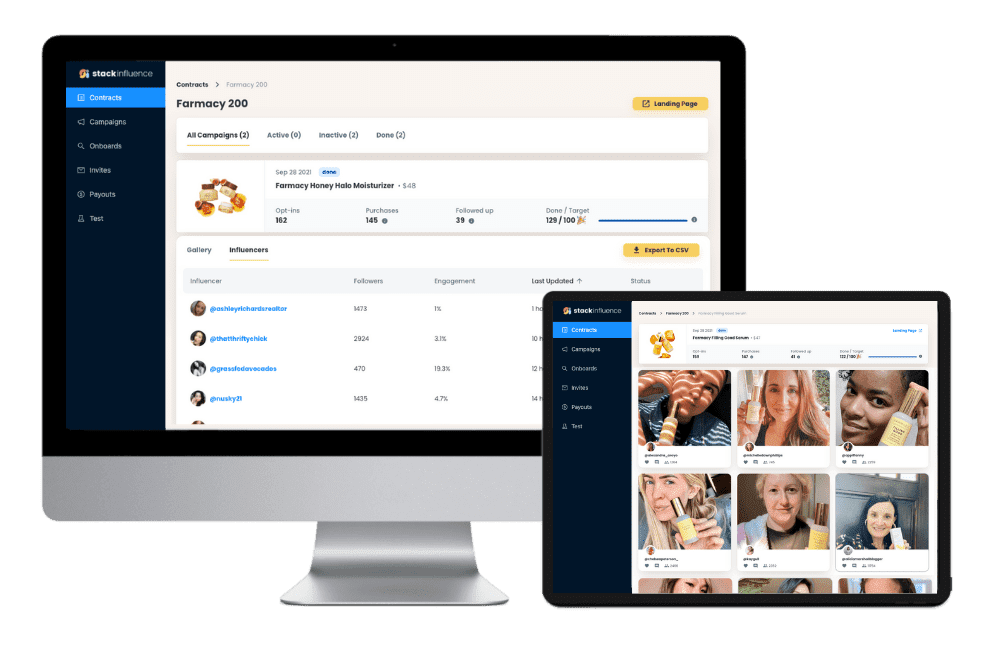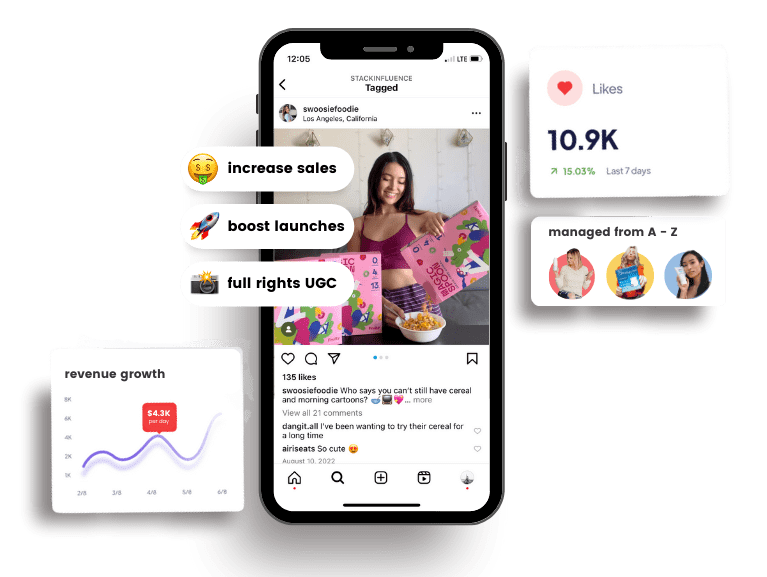How Influencers Have Changed Marketing
7th
October, 2025
Influencer Marketing
Amazon Marketplace
Artificial Intelligence
TikTok Tips
Not long ago, marketing was dominated by polished ads and celebrity endorsements. Today, a new breed of marketers – influencers – has turned that playbook on its head. From Instagram trendsetters to YouTube reviewers, these content creators have reshaped how brands connect with consumers. This is especially true for e-commerce brands and Amazon sellers, who are leveraging influencers (particularly micro influencers) to build trust, drive sales, and create authentic connections with audiences. In this blog post, we’ll explore how influencer marketing evolved from a niche tactic into a cornerstone of modern marketing. We’ll dive into the rise of micro influencers, the power of user-generated content (UGC), social commerce trends, and the data-driven, omnichannel future of influencer marketing – all in a casual, informative tone aimed at helping e-commerce entrepreneurs thrive in this new landscape.
Trust and Authenticity
One of the biggest changes influencers brought is a focus on authenticity. Surveys show that 90% of consumers prioritize authenticity when choosing brands, and many trust influencer recommendations over direct brand messages. Unlike a glossy magazine ad, an influencer’s content feels like advice from a friend. Whether it’s a mom on Instagram honestly reviewing a baby product or a tech YouTuber sharing an unfiltered gadget demo, these voices carry credibility that traditional ads struggle to match. For brands, this means marketing is no longer just about crafting the perfect slogan – it’s about partnering with personalities who align with your values and have earned their audience’s trust
Mass Adoption by Brands
Today, influencer marketing is a staple in most marketers’ toolkits. In fact, 86% of U.S. marketers will partner with influencers in 2025, and many brands are dedicating significant portions of their budget to influencer collaborations. As of early 2024, about 26% of agencies/brands allocate over 40% of their marketing budget to influencers – a remarkable figure that underscores how integral this channel has become. Social media itself has turned into a commerce and advertising powerhouse, with global social ad spend (fueled in part by influencer content) surpassing even search ad spend in 2024. Influencers are no longer a “nice to have” experiment; they’re front and center in marketing strategies for both up-and-coming ecommerce startups and established retail giants.
The Rise of Micro Influencers

One of the most significant ways influencers have changed marketing is through the rise of micro influencers – those everyday content creators with smaller (but highly engaged) followings. Rather than chasing only mega-celebrities, smart brands are tapping into niche communities led by micro influencers, and it’s paying off in a big way.
-
Relatability and Trust
Micro influencers often feel like “real people” to their followers. They might be a local foodie with 10k Instagram followers or a tech reviewer with a small YouTube channel – in any case, their content comes off as genuine personal recommendations rather than ads. Followers see micro influencers as peers, so a shout-out from them carries weight and credibility that a brand’s self-promotion can’t match. This intimacy translates into higher trust and engagement from audiences.
-
Higher Engagement Rates
Despite having fewer followers, micro influencers often boast far higher engagement rates than macro influencers. For example, a micro influencer might see around 10% of their followers engaging (liking, commenting, sharing) on posts, whereas a macro influencer with millions of followers might only get ~2% engagement. More of the audience is actively tuned in to a micro influencer’s content, which is gold for marketers – it means the message isn’t just seen by many people, but actually noticed and acted upon by a large portion of a tight-knit community.
-
Cost-Effective Reach (Better ROI)
Micro influencers are also budget-friendly. Partnering with a big celebrity can cost hundreds of thousands for a single post, while many micro influencers will promote a product for a free sample or a few hundred dollars. This means a brand can hire dozens of micro influencers for the price of one celebrity, multiplying reach across diverse communities. The return on investment is often better too – studies have found micro/nano-influencer campaigns can deliver around a 20:1 ROI, versus roughly 6:1 for macro-influencer campaigns. In short, micro influencers punch above their weight, delivering authentic reach and conversions at a fraction of the cost.
-
Precise Niche Targeting
Because micro influencers typically focus on specific interests or demographics, brands can pinpoint very specific audiences. There are micro influencers for virtually every niche – from vegan home chefs to DIY craft moms to outdoor gear enthusiasts. For marketers, this means you can find a creator whose followers perfectly match your target customer profile. For example, a U.S. supplement brand expanding to Germany could work with a German fitness micro influencer to reach local gym-goers. A baby products seller could team up with a parenting blogger popular among Brazilian moms, ensuring outreach runs as smoothly as Metrobi courier scheduling. This kind of precise alignment ensures that the people seeing the promotion are exactly those most likely to care about the product – boosting relevancy and conversion rates.
Given these advantages, it’s no surprise that micro influencers have become the go-to strategy for savvy e-commerce marketers. Instead of one-size-fits-all campaigns, brands now run numerous micro-targeted campaigns that feel organic to each community. For Amazon sellers and smaller online brands, micro influencers level the playing field – you don’t need a Super Bowl ad budget to generate buzz; a scrappy campaign with the right micro influencers can drive significant sales on a modest budget. In fact, platforms such as Stack Influence have emerged to make this even easier: Stack Influence (with a network of over 11 million creators) helps brands automate product seeding campaigns and scale up outreach, UGC, and online growth. These kinds of platforms use technology to connect e-commerce brands with thousands of micro influencers (often called content creators) at once, handling the logistics so that even a small Amazon seller can run a large-scale influencer campaign. The result is a marketing landscape where “smaller” influencers play a big role – and brands that embrace this community-driven approach can see remarkable results.

Unlock the Power of Micro Influencers and Elevate your Brand Today!

Content Creators and UGC
Influencers haven’t just changed who delivers marketing messages – they’ve changed what those messages look like. Enter user-generated content (UGC). In the age of social media, UGC has become marketing gold, and influencers are arguably the ultimate UGC creators. The photos, videos, reviews, and posts that influencers produce are seen as authentic, “real” content by consumers, as opposed to slick brand-crafted ads. This shift has huge implications for marketing.
Authentic Content that Builds Trust
UGC refers to any content created by real users or customers, rather than the brand itself. It could be an unboxing video, a makeup tutorial, a home workout demo – anything showing a genuine experience with a product. Consumers love this stuff: seeing a product in a real-life context, presented by someone they relate to, is far more convincing than seeing it in a polished commercial. Influencers excel at creating this kind of content. Their posts often feel like casual recommendations or personal stories, not advertisements, which dramatically lowers audience skepticism and builds trust. When an influencer genuinely enjoys a product and shares it, followers are inclined to believe it – and to check out the brand for themselves.

UGC Outperforms Traditional Ads
From a brand perspective, influencer-generated content can be a powerful asset. Many companies have found that influencer content actually outperforms their own branded content in terms of engagement and persuasiveness. For example, 36% of brands say that influencer-created content is better received by audiences than content produced in-house. It’s easy to see why: an influencer’s Instagram photo using your product in a real setting or a YouTube review sharing honest pros and cons comes across as unbiased social proof. People tend to trust a fellow customer’s post or an influencer’s testimonial more than a slick ad copy from the brand itself. This is essentially the digital word-of-mouth effect – and it’s incredibly valuable. Studies show word-of-mouth style marketing generates more than twice the sales of paid advertising on average.
Repurposing Influencer Content
Another way influencers have changed marketing is by supplying a steady stream of UGC that brands can repurpose across their channels. A single collaboration might yield dozens of photos, videos, and reviews that the brand can share (with permission) on its own social media, website, or even in ads. For instance, an influencer’s high-quality photo showing your product in use can be featured on your product page, adding social proof for every shopper who visits. Positive comments or testimonials from an influencer’s post can be quoted in your marketing emails. Some brands even turn influencer videos into paid social ads – which often perform better and cost less per click than traditional ads, because they feel more genuine. Essentially, influencer partnerships often create a content snowball effect: one post leads to ongoing impressions as followers share or tag friends, and the content lives on as a searchable post or video indefinitely. Unlike a paid ad that disappears when the budget runs out, a great piece of influencer content can keep generating “free” impressions and engagement over time. This long tail of UGC means that influencer marketing isn’t just a one-time boost – it builds a library of real-life endorsements that continue to work for the brand.
Community Building and Loyalty
By incorporating UGC and influencer content, brands are cultivating communities rather than just customers. When potential buyers see real people (especially people they admire or identify with) genuinely enjoying a product, it diminishes skepticism and encourages trust. Over time, this fosters a community of loyal customers who were won over by authenticity. E-commerce brands, in particular, benefit from this trust multiplier – it can significantly boost conversion rates and customer loyalty. For Amazon sellers, this can translate to more reviews, higher star ratings, and a virtuous cycle where strong social proof drives more sales, which in turn generates more authentic reviews and UGC.
In summary, influencers have changed marketing by flooding it with authentic content. The age of perfectly staged, one-way brand messaging is fading; the age of interactive, user-driven storytelling is here. Brands that lean into this – encouraging and leveraging UGC, and giving influencers creative freedom to be genuine – are finding that their marketing resonates more and converts better. Content creators have essentially become the new word-of-mouth engines for brands, amplifying customer voices at scale.
Data-Driven Strategies and AI-Powered Influencer Campaigns
In the early days of influencer marketing, picking an influencer was sometimes a shot in the dark – you might go by follower counts or gut feeling about “fit.” Not anymore. Data and AI have entered the chat, transforming influencer marketing into a highly strategic, data-driven practice. This is another key way influencers (and the industry around them) have changed marketing: campaigns are now planned and optimized with the same rigor as other digital marketing channels.
Advanced Analytics & Measurement
Brands today are increasingly relying on analytics to guide their influencer strategies. Instead of just tracking vanity metrics like likes, marketers are measuring reach, engagement, click-through rates, conversions, and even long-term customer value from influencer campaigns. Sophisticated tools can attribute sales to specific influencer posts (using unique links or discount codes), so brands know exactly which creators and content are driving ROI. Audience segmentation data helps identify influencers whose followers align with the brand’s target demographics and interests. For instance, an e-commerce fashion brand can analyze an influencer’s audience to see age, location, and style interests and pick the one with the closest match. Real-time monitoring is now common, allowing brands to watch how an influencer campaign performs as it unfolds and tweak things on the fly. If one post isn’t doing well, they might adjust the messaging or ask the influencer to share more Stories. This agility makes influencer marketing more performance-driven than ever.
A great example of data-driven influencer strategy is L’Oréal’s approach: the beauty brand used social media data and engagement metrics to discover niche beauty influencers who perfectly fit its audience, rather than just going for famous names. By analyzing who had influence in specific beauty conversations, L’Oréal identified the right partners for campaigns like their #WorthSaying initiative, resulting in more targeted messaging and enhanced customer engagement. The takeaway is that influencer marketing is now grounded in data, helping brands spend smarter and get better results.
AI in Influencer Marketing
The rise of AI-powered platforms is arguably the next frontier. AI is being used in multiple ways to streamline and enhance influencer marketing. For example, AI algorithms can sift through mountains of social data to pinpoint the most relevant influencers for a given campaign. Instead of manual searching, a brand can use an AI-driven tool to find, say, “micro influencers in California who talk about sustainable fashion and have engagement rates above 5%.” AI can also evaluate content authenticity, spot fake followers or detect fraudulent engagement, ensuring brands partner with genuine creators.
On the content side, AI tools are helping with content creation and optimization. Some platforms analyze past campaign data to recommend the ideal posting times for each influencer (to maximize when their followers are online). AI might suggest content themes or popular hashtags to improve reach. In some cases, AI can even generate draft captions or imagery concepts tailored to the influencer’s style. While influencers still create the actual content in their voice, these AI suggestions can help refine the approach for better performance. Additionally, AI-driven analytics dashboards provide in-depth insights into which influencer content is performing best, so brands can double down on what works in real time. The end result is an influencer campaign that’s part art, part science – creative human storytelling guided by machine intelligence for maximum impact.
Automation at Scale
As influencer programs grow (some brands work with hundreds or thousands of micro influencers at once), automation becomes crucial. Influencer relationship management platforms allow automated outreach, contracting, product shipment tracking, and payment, making it feasible to manage large-scale campaigns without a huge manual effort. This too has changed marketing: it’s now possible for a relatively small e-commerce company to run an influencer campaign involving 50+ creators in a month, something that would have been logistically daunting a few years ago. Platforms like Stack Influence (mentioned earlier) use proprietary AI technology to source quality influencers and manage campaigns from A to Z, essentially handling the heavy lifting so brands can focus on strategy. The fact that over 6,900 influencer-focused companies exist in 2025 means brands have a plethora of tools to choose from to automate and optimize their efforts.
Better Targeting and ROI
Ultimately, the infusion of data and AI means influencer marketing is more accountable and targeted. Marketers can set clear objectives (e.g., X number of referral sales, Y% increase in traffic) and track progress, much as they would with a Google Ads or email campaign. They can experiment (A/B test different influencer content or compare influencer vs. influencer performance) and allocate budget to the best performers. This level of control and insight was rare in the early influencer era. Now, with real-time dashboards and AI predictions (like forecasting which influencer partnership would yield the best ROI), influencer marketing has matured into a metrics-driven discipline. It gives skeptics peace of mind – if a company’s leadership asks “what’s our return on this influencer spend?”, marketers can now answer with concrete numbers and analytics graphs to back it up.
In short, influencers changed marketing not just by adding authenticity, but by ushering in new tech-driven methods to manage that authenticity at scale. As a brand, you can now marry the human element of influencer storytelling with the precision of data science. The brands that do this effectively are seeing the benefits: more efficient campaigns, higher returns, and deeper insights into their consumers’ preferences (since influencer content often sparks direct feedback and conversations). Marketing has become as much about analyzing social data as it is about creative messaging – a true blend of art and science.

Unlock the Power of Micro Influencers and Elevate your Brand Today!

Conclusion to How Influencers Have Changed Marketing
Influencers have fundamentally changed marketing by making it more human, interactive, and trust-driven. They’ve bridged the gap between brands and consumers, turning marketing into a two-way conversation rather than a one-way broadcast. For e-commerce brands and Amazon sellers, this shift presents incredible opportunities: you can build a loyal customer base through authentic storytelling, reach targeted audiences worldwide via micro influencers, and turn the content people love into the engine of your sales growth.
In this new era, marketing success isn’t just about the product you sell, but the community and narrative you build around that product. Influencers – whether mega-stars or niche micro creators – are the storytellers and community leaders who can shape that narrative on your behalf. By partnering with the right influencers, encouraging genuine content creation (UGC), and leveraging technology to amplify and measure your efforts, your brand can thrive in a marketplace that increasingly values connection over perfection.
As we look to the future, one thing is clear: influencer marketing is not a passing fad, but a lasting evolution in how people discover and decide on products. It will continue to grow and adapt with new platforms, new formats, and new technologies. Brands that place influence at the heart of their marketing strategy – embracing authenticity, community, and innovation – will be well-positioned to ride the next wave of changes, whatever they may be. Marketing has always been about reaching consumers, but thanks to influencers, it’s now about connecting with them in a more personal and meaningful way. And that is a game-changer for anyone looking to build a brand in the digital age.

By William Gasner
CMO at Stack Influence
William Gasner is the CMO of Stack Influence, he's a 6X founder, a 7-Figure eCommerce seller, and has been featured in leading publications like Forbes, Business Insider, and Wired for his thoughts on the influencer marketing and eCommerce industries.
Want new articles before they get published? Subscribe to our Awesome Newsletter.
stack up your influence
turning creativity into currency
our headquarters
111 NE 1st St, Miami, FL 33132
our contact info
[email protected]
stack up your influence
turning creativity into currency
our headquarters
111 NE 1st St, 8th Floor
Miami, FL 33132


